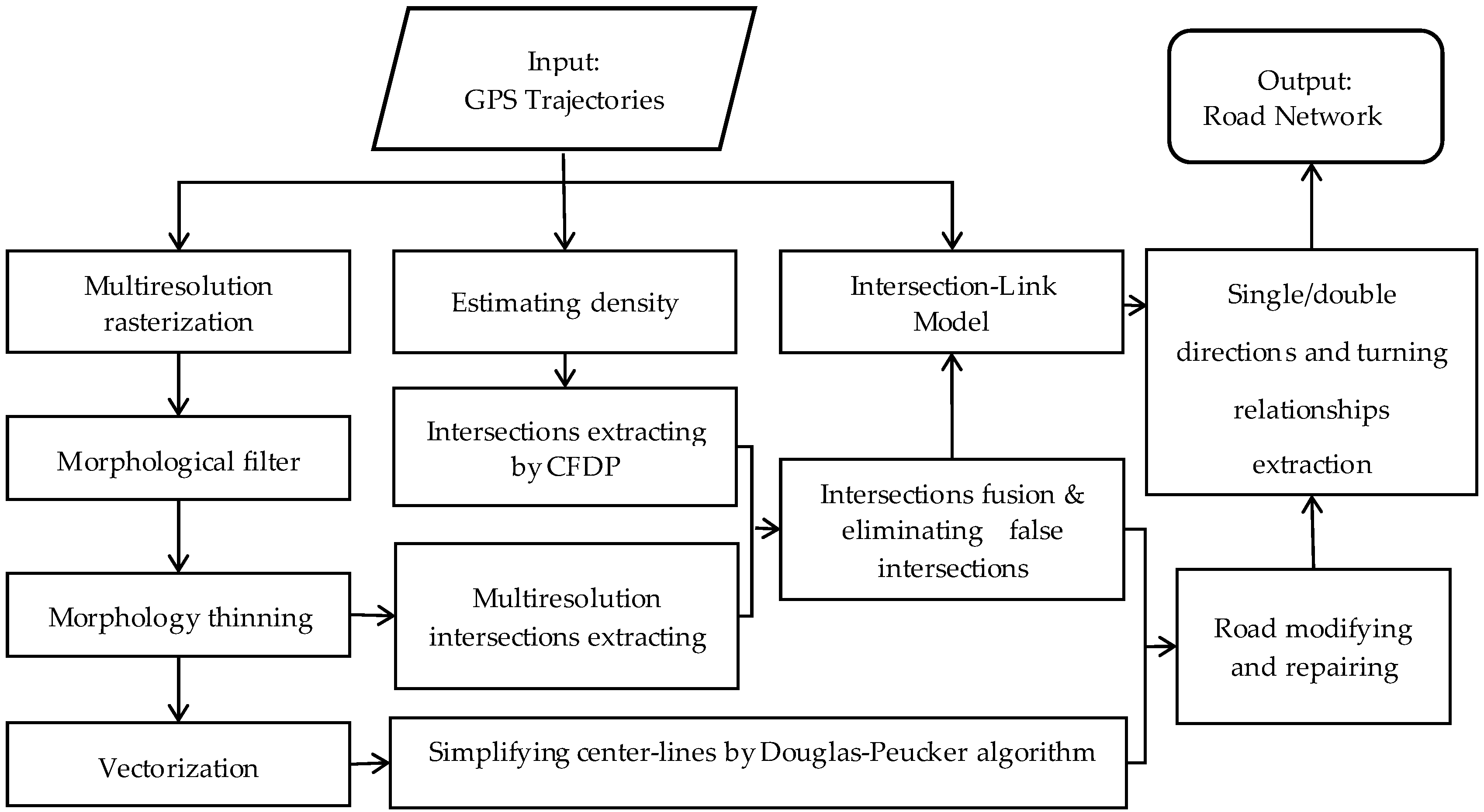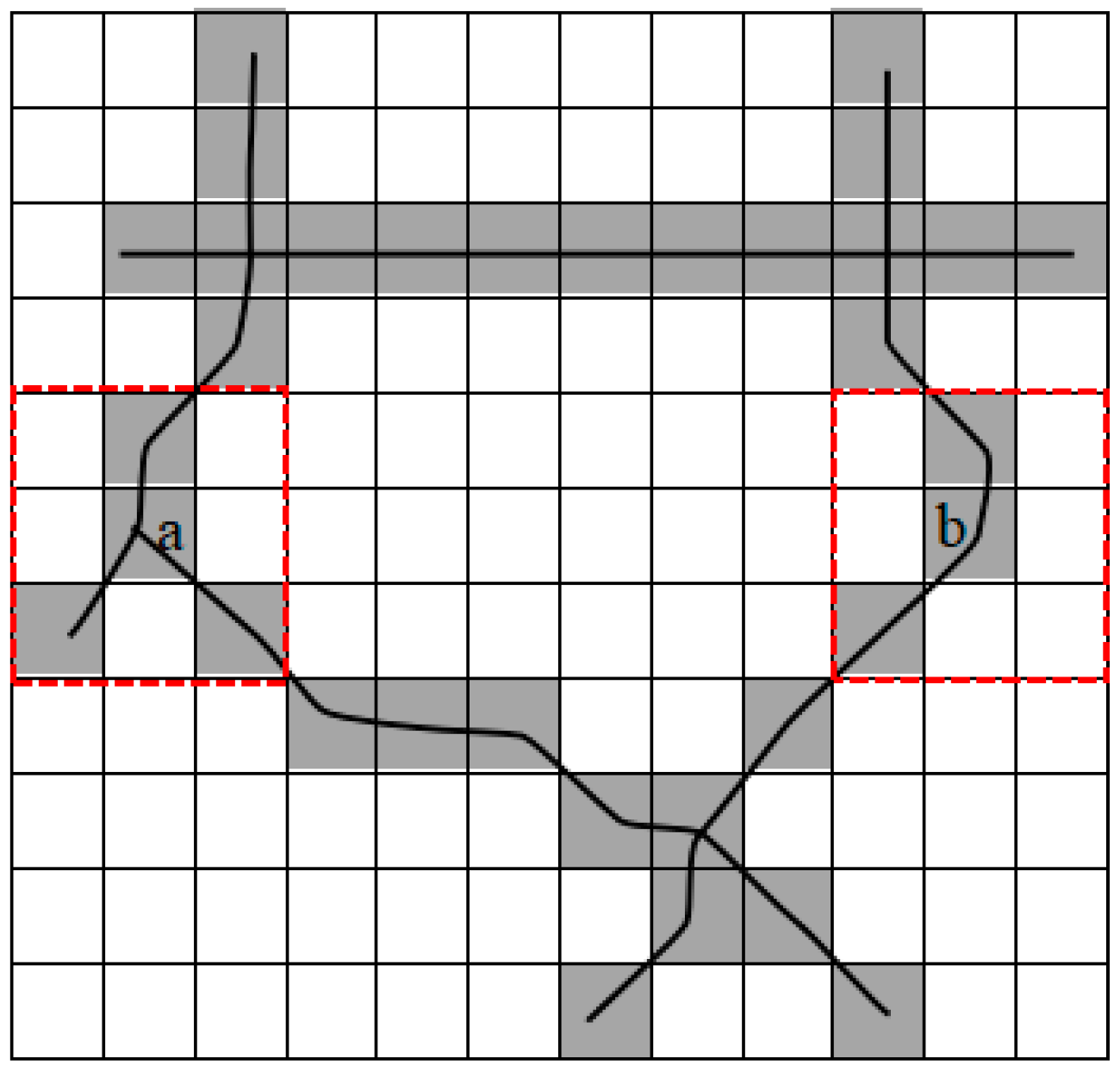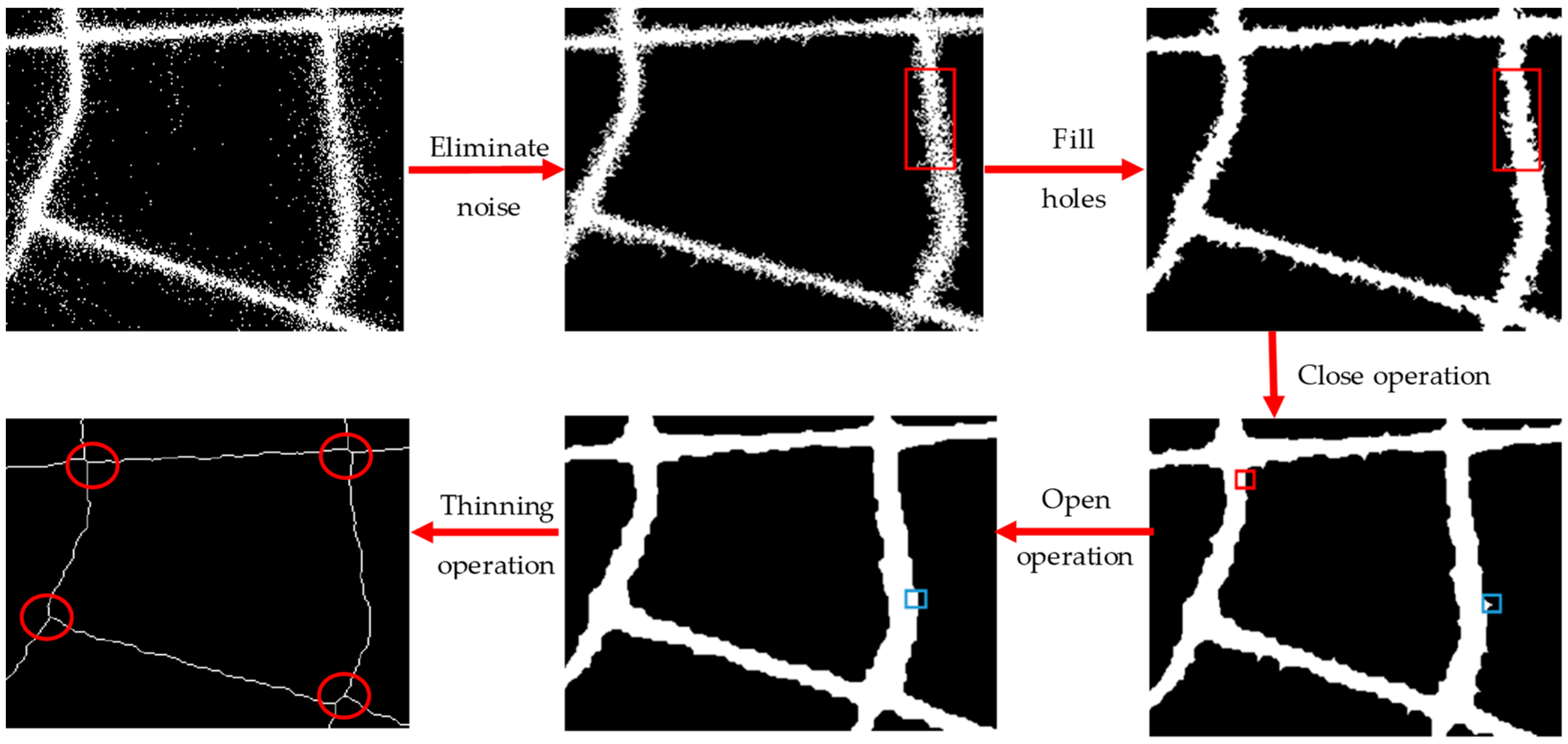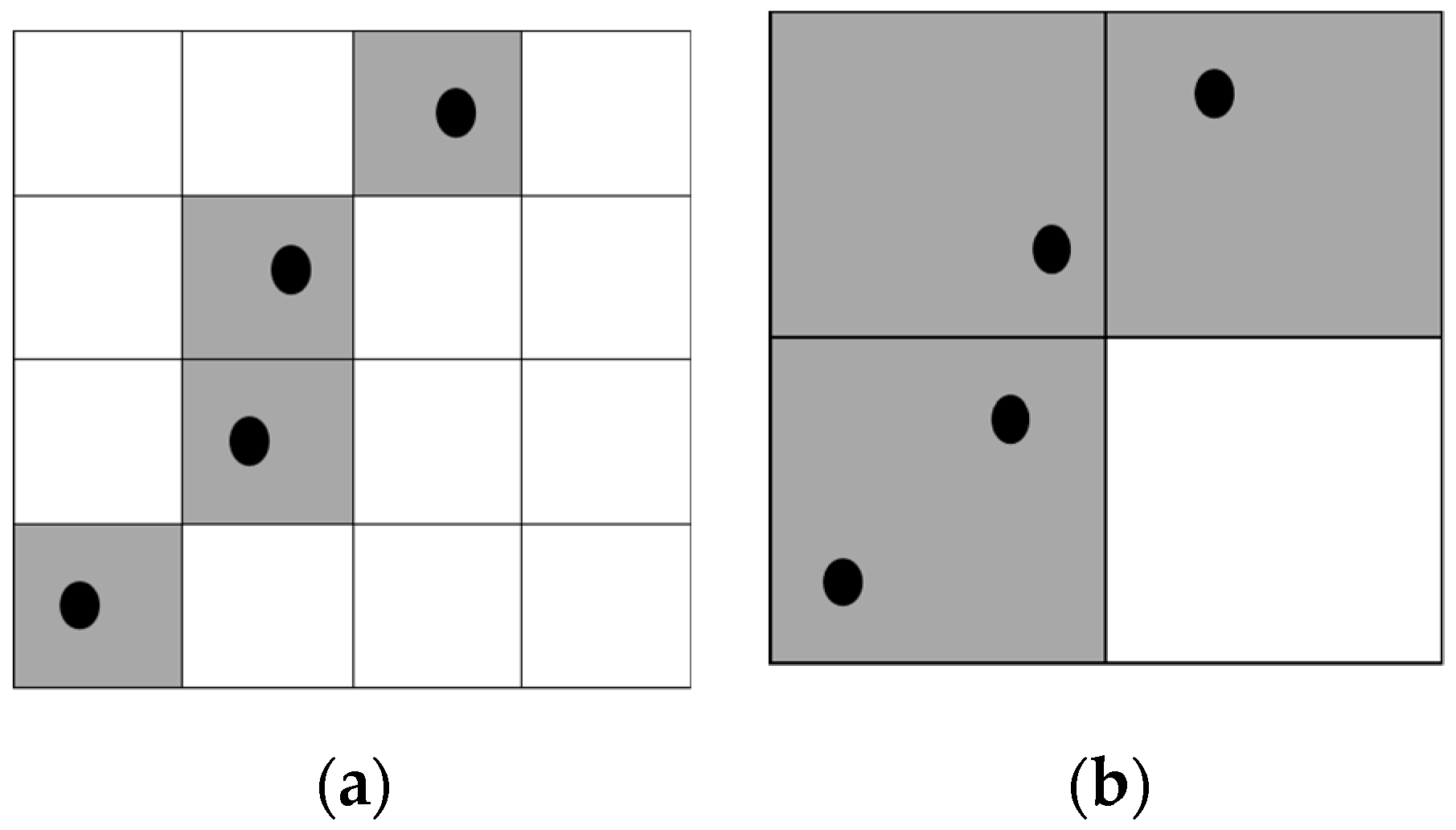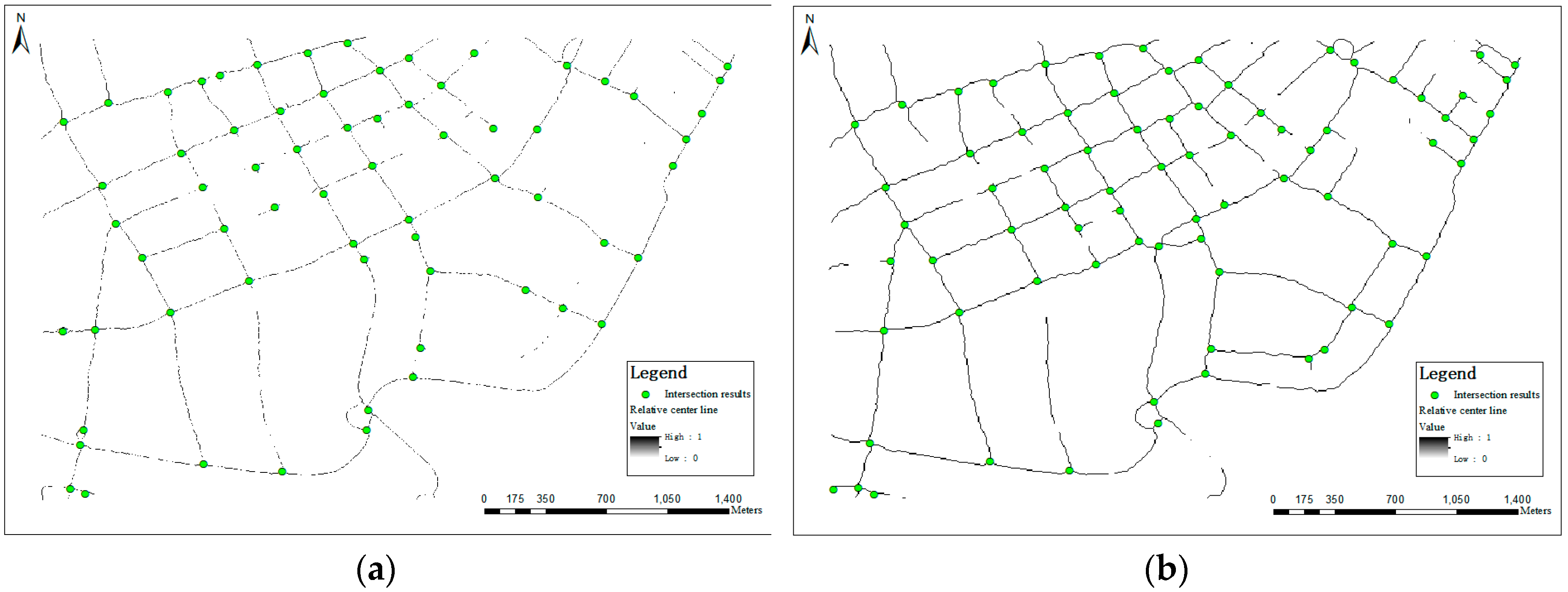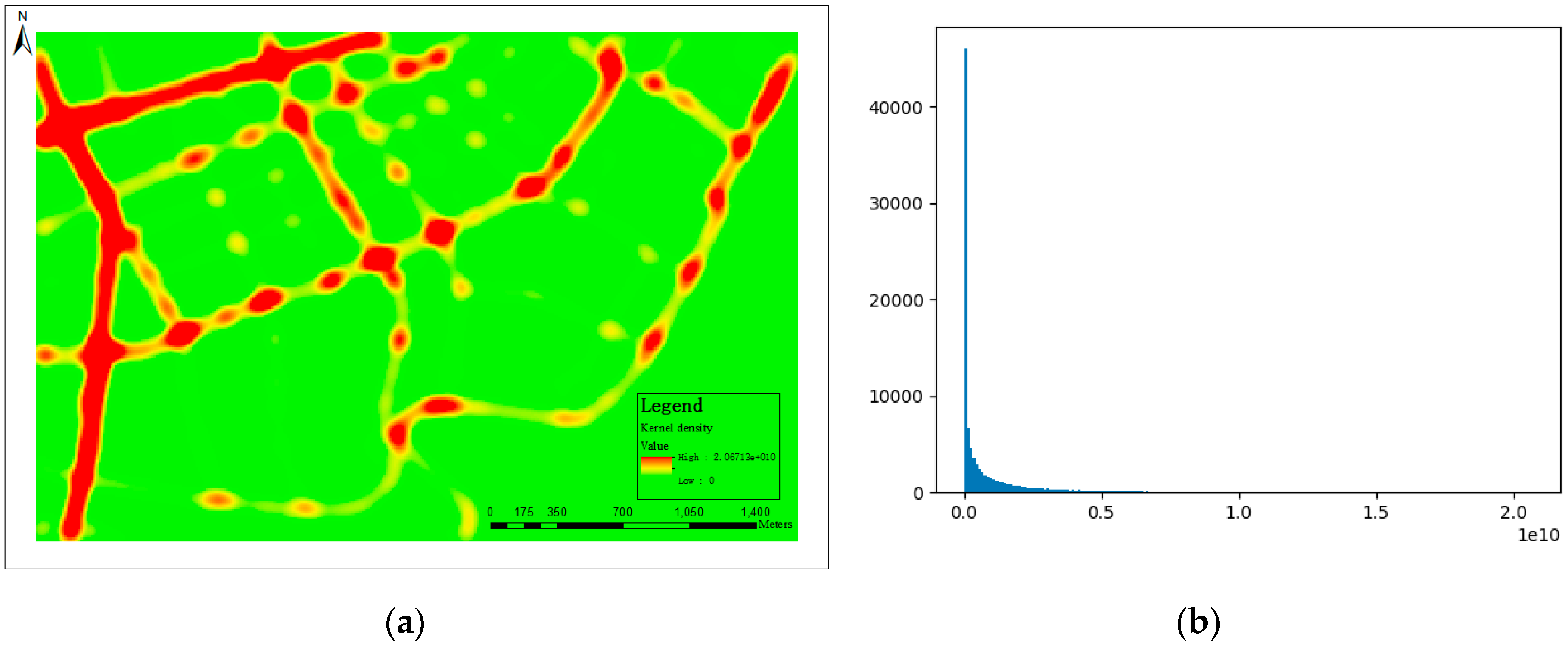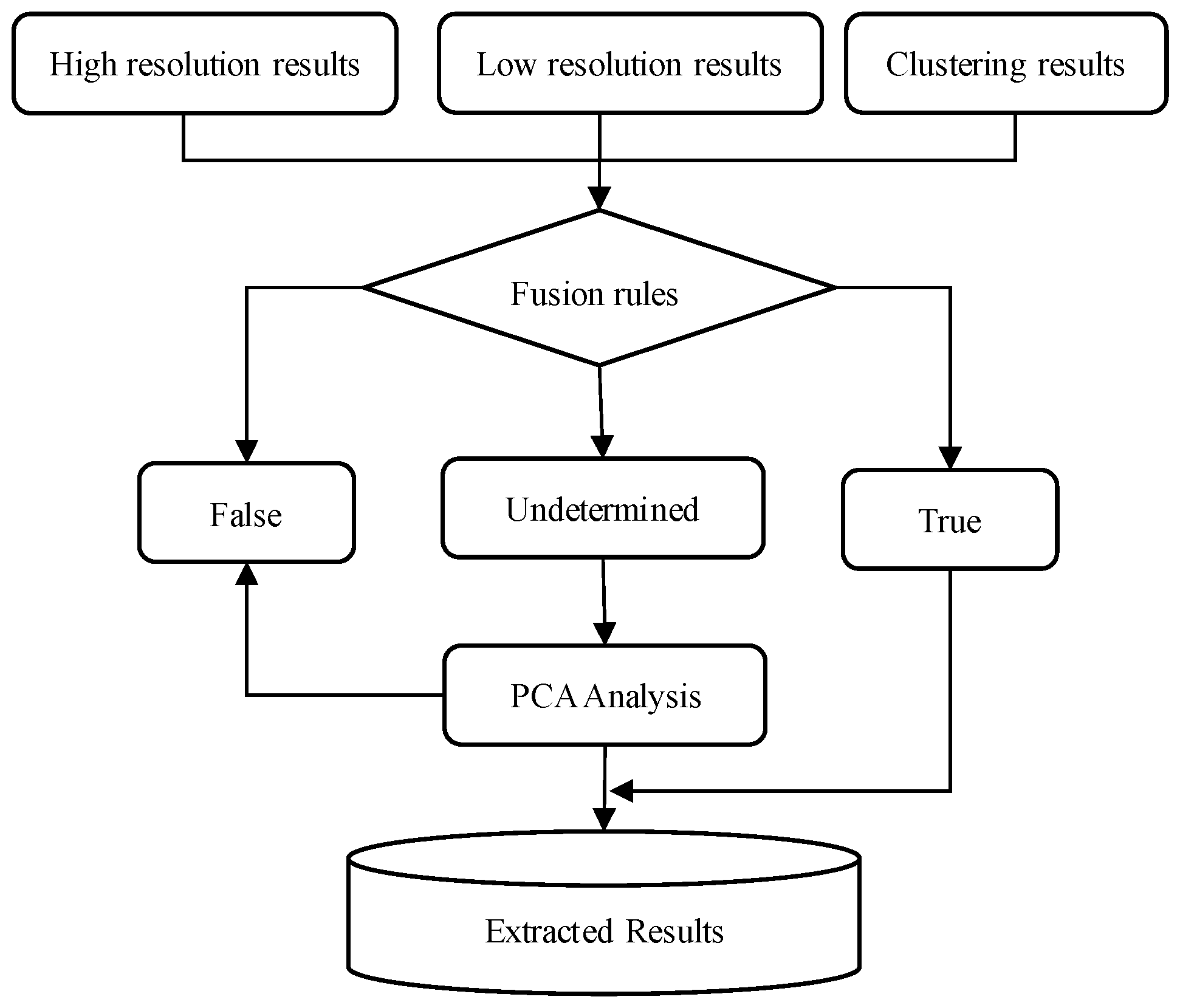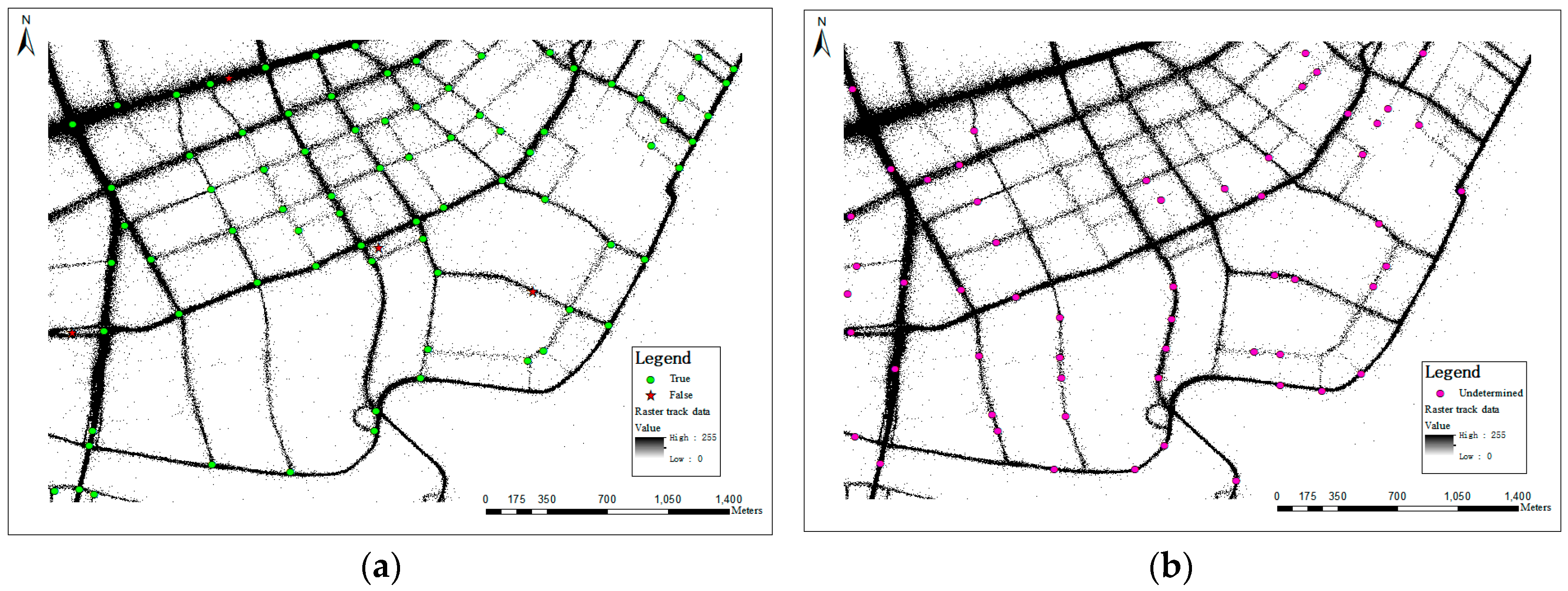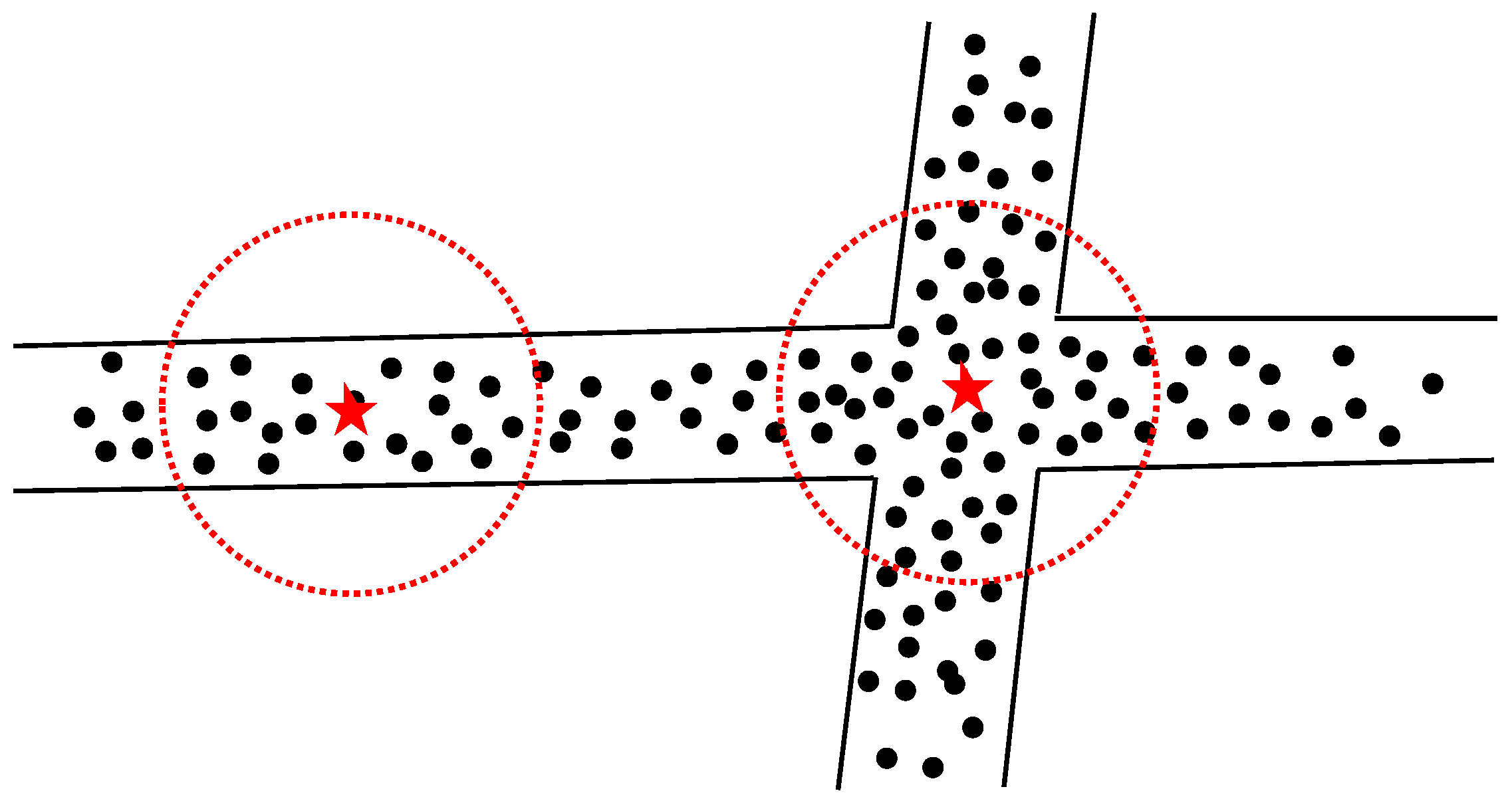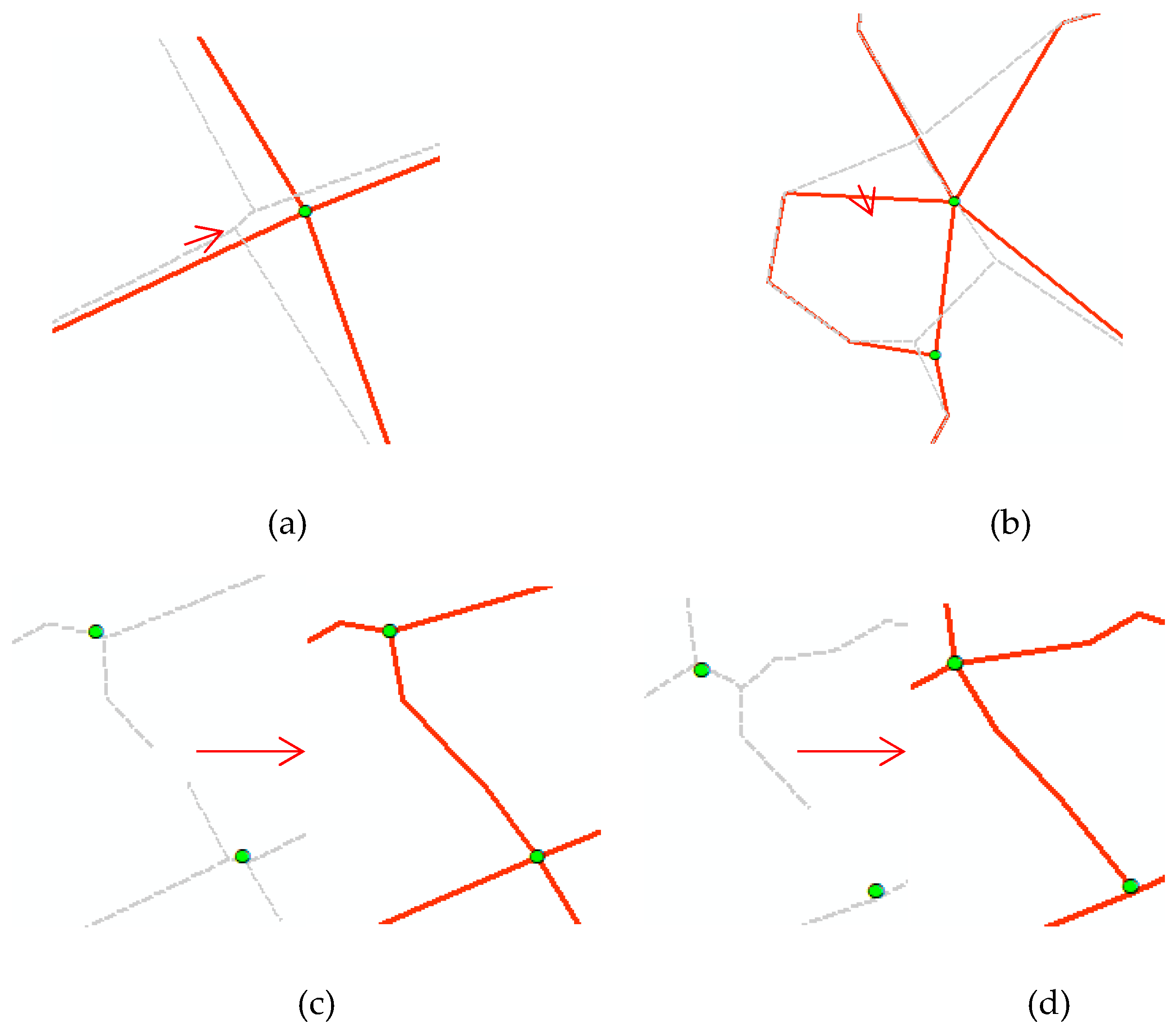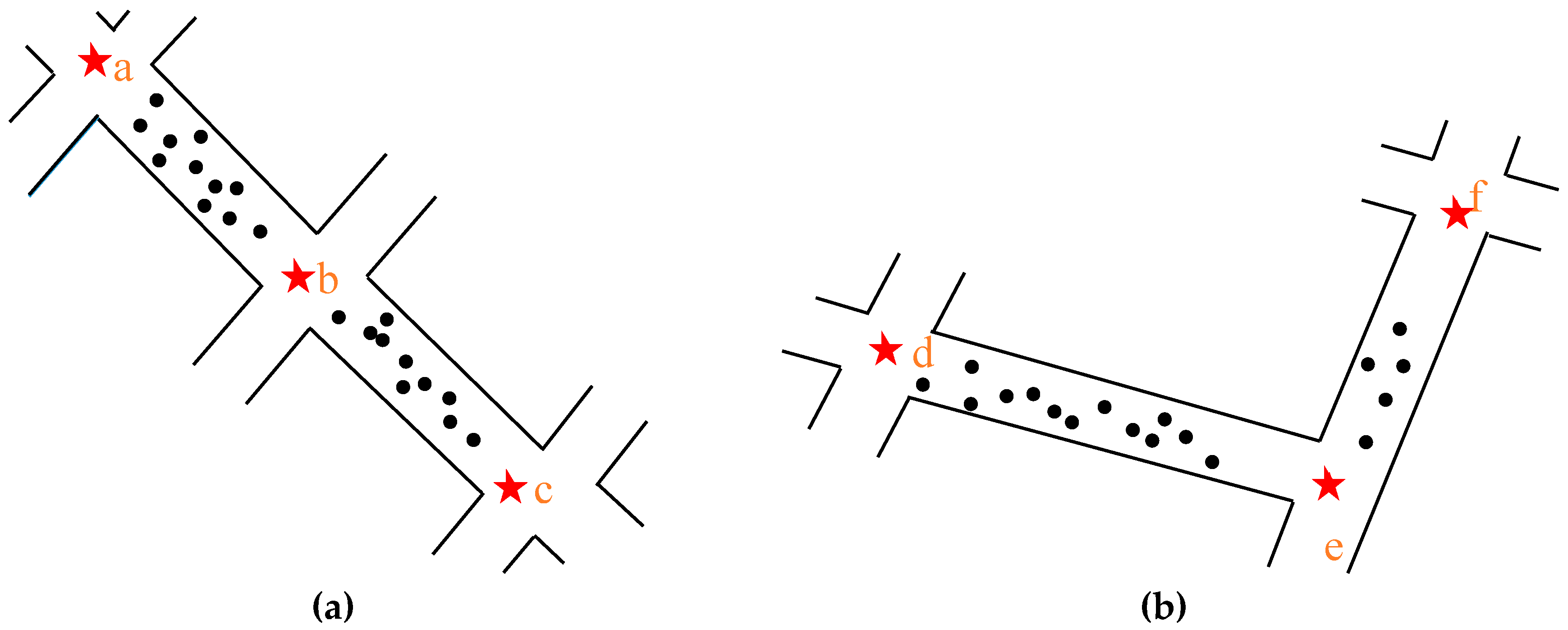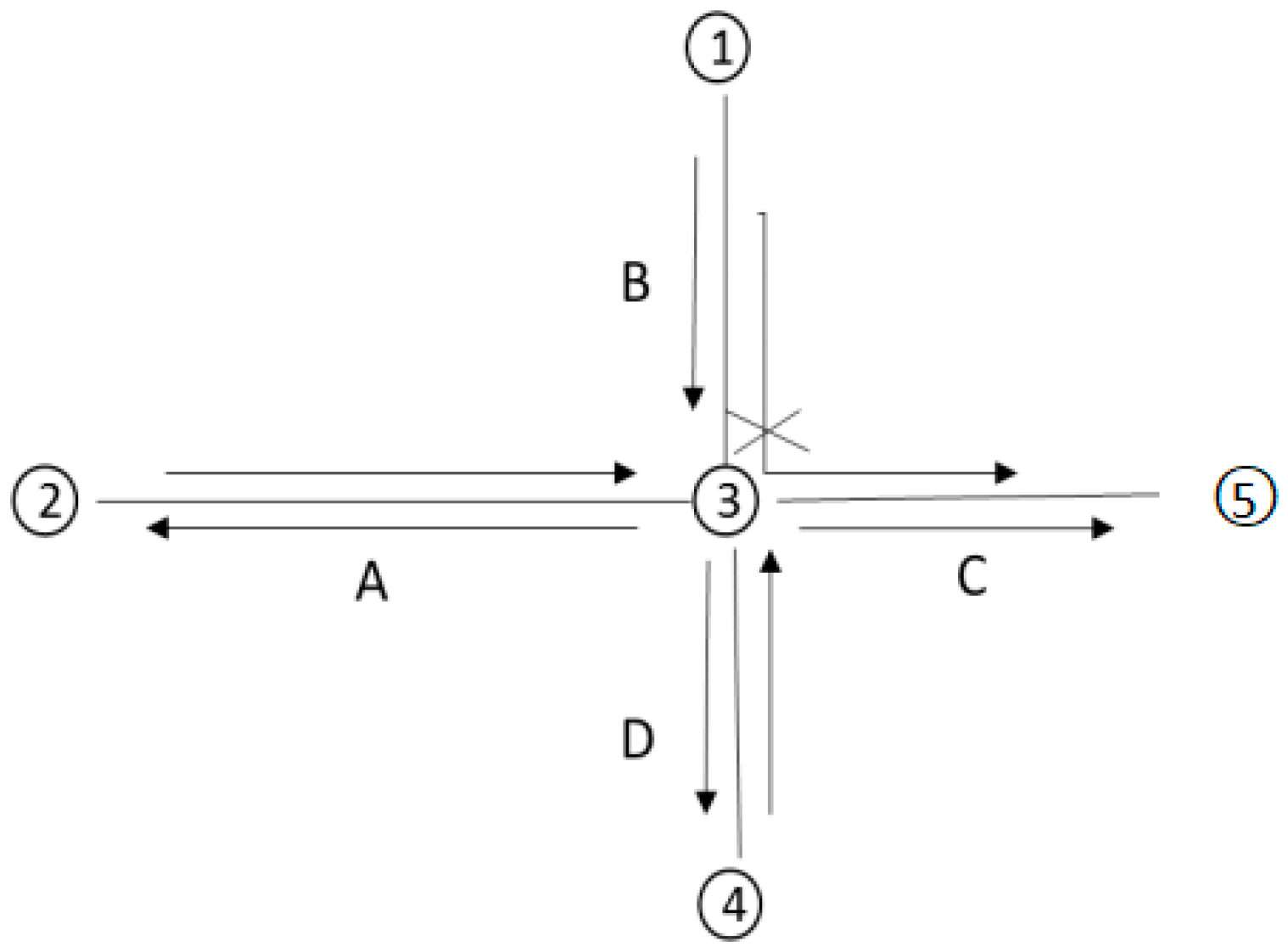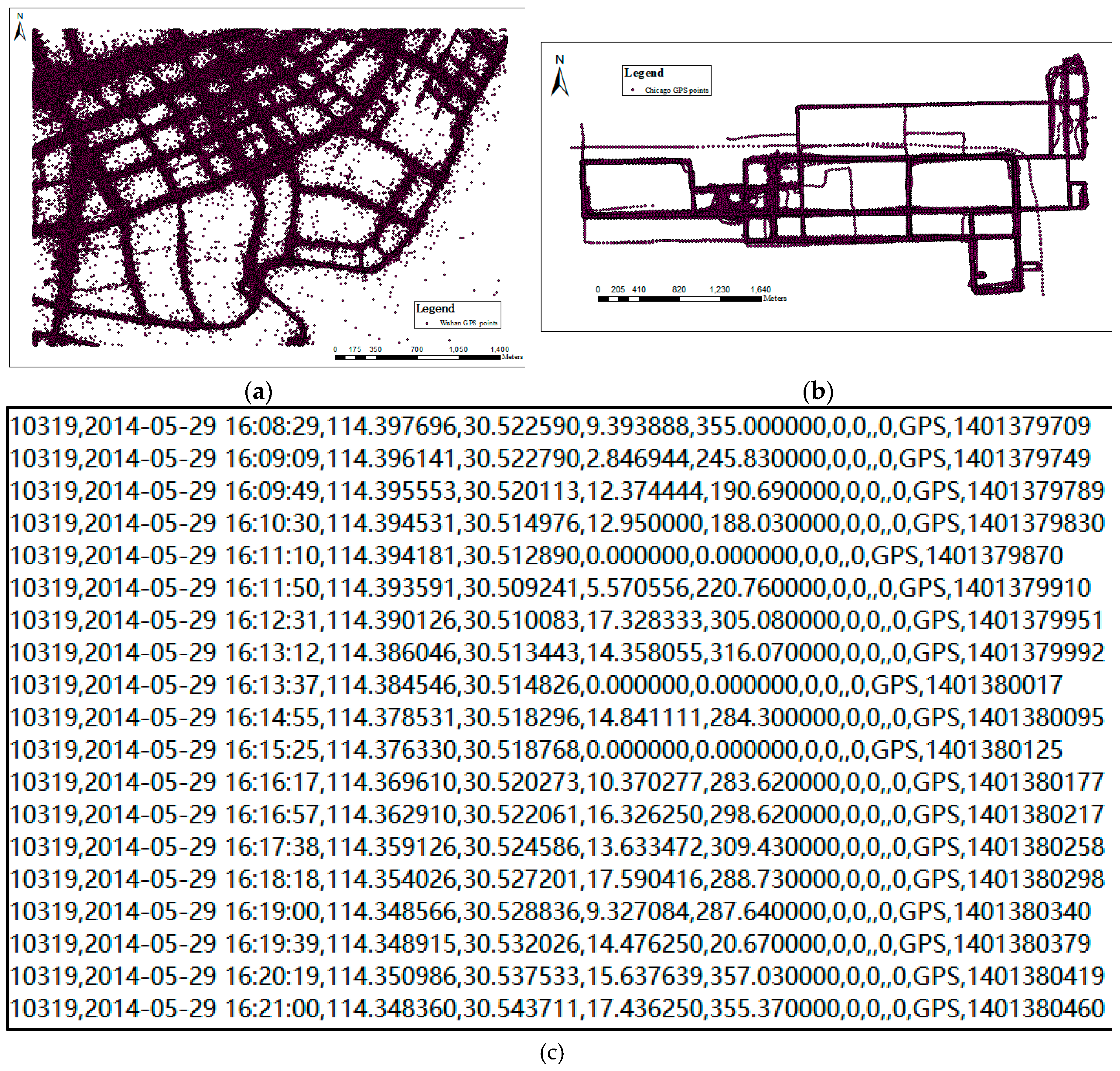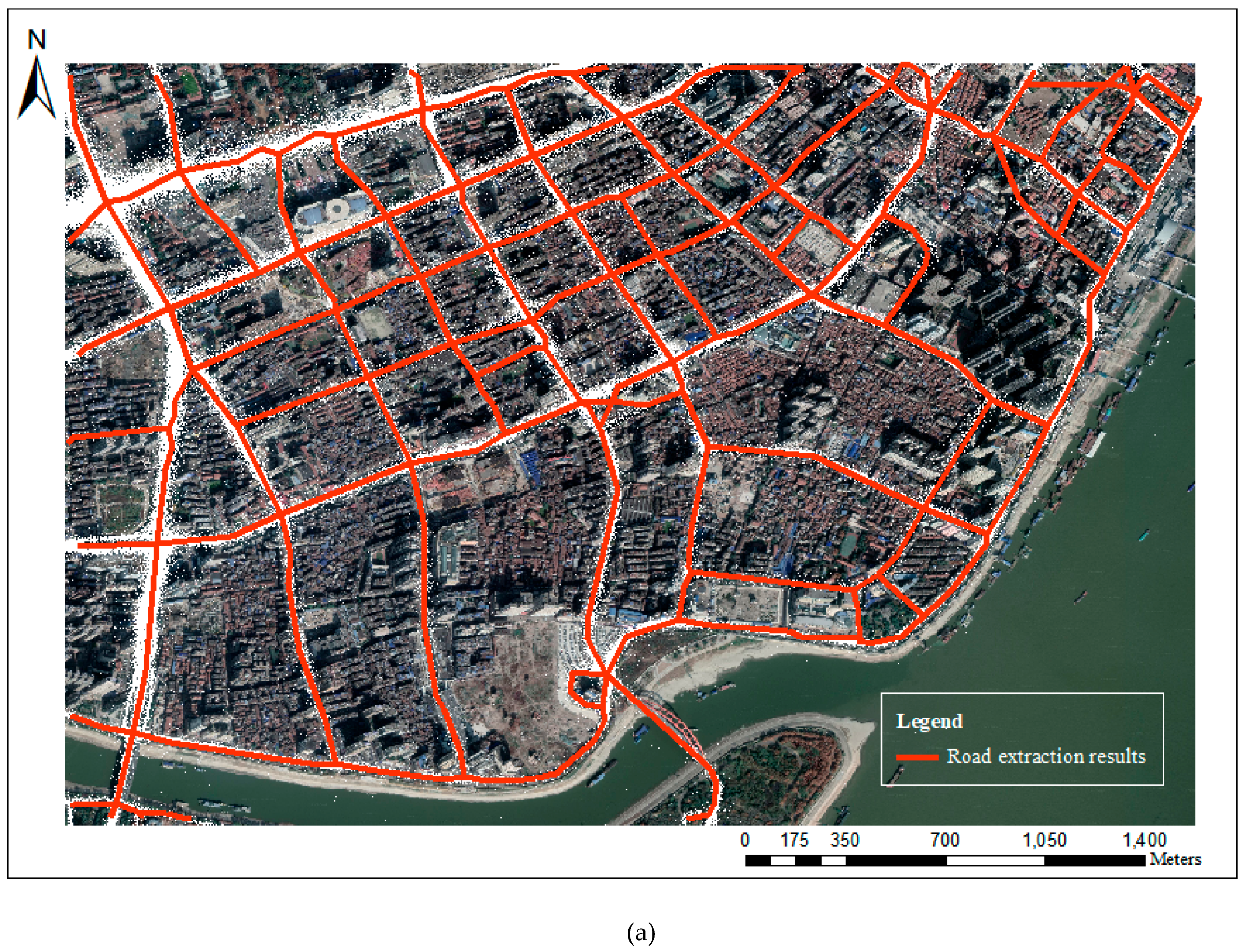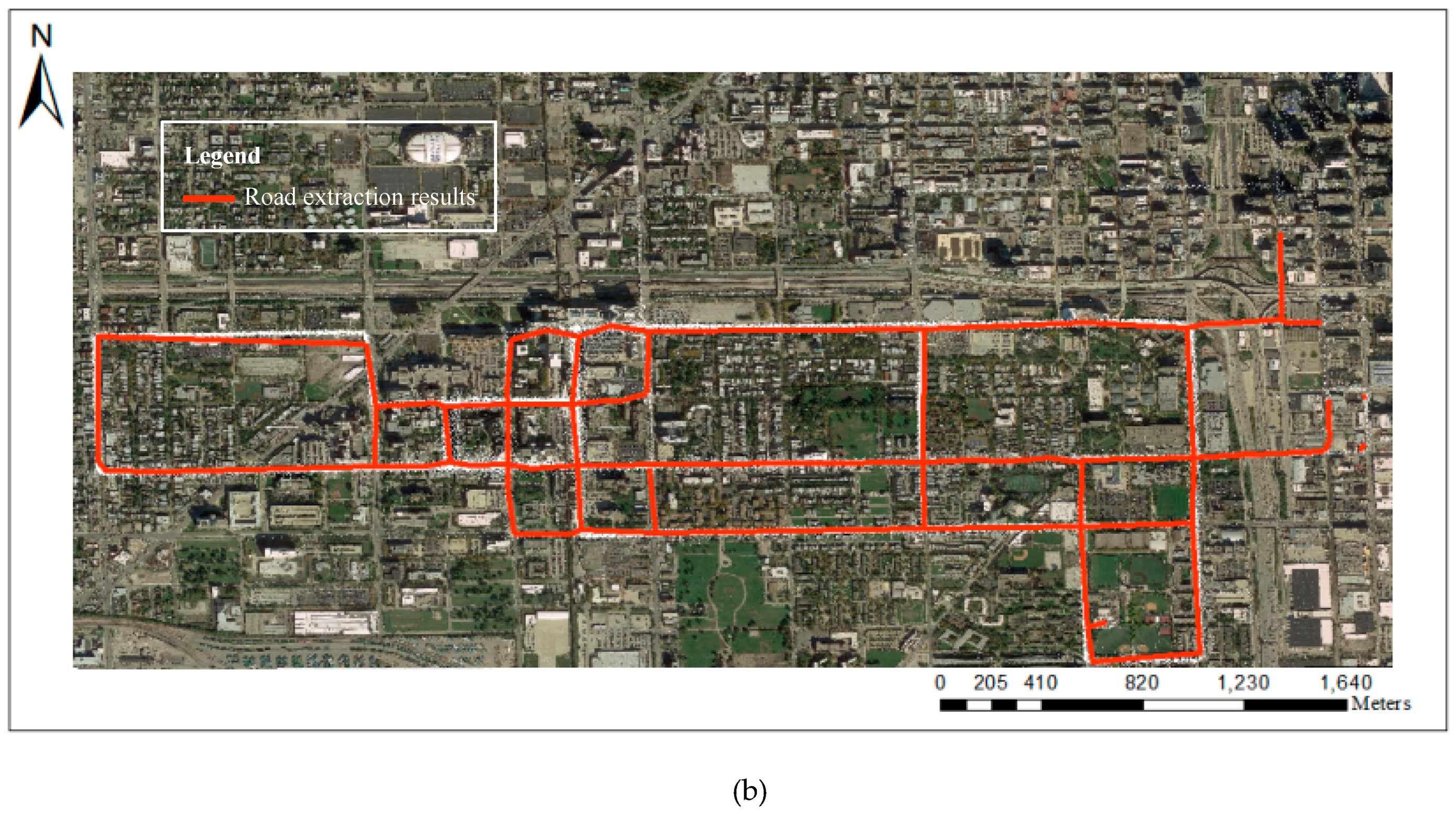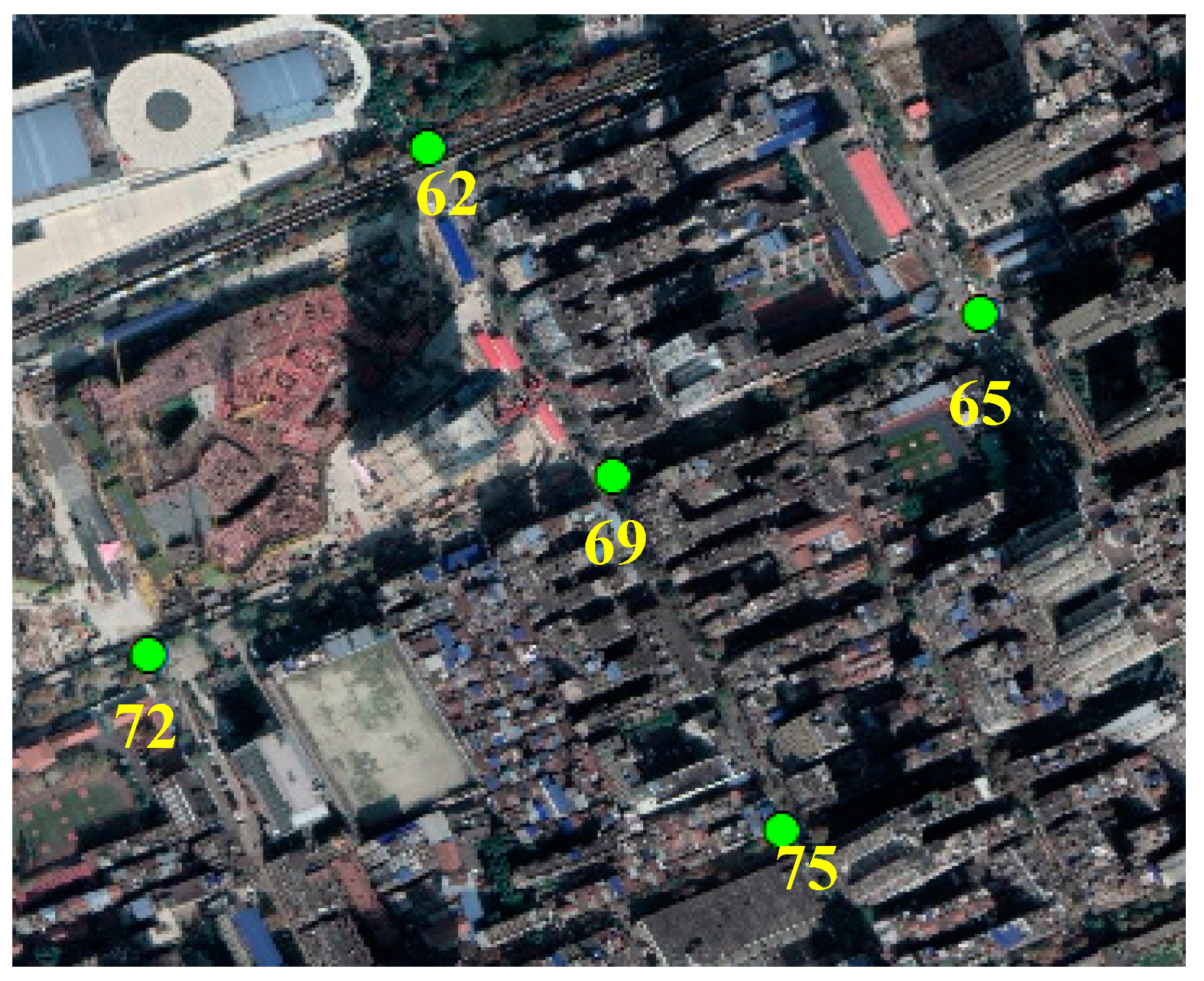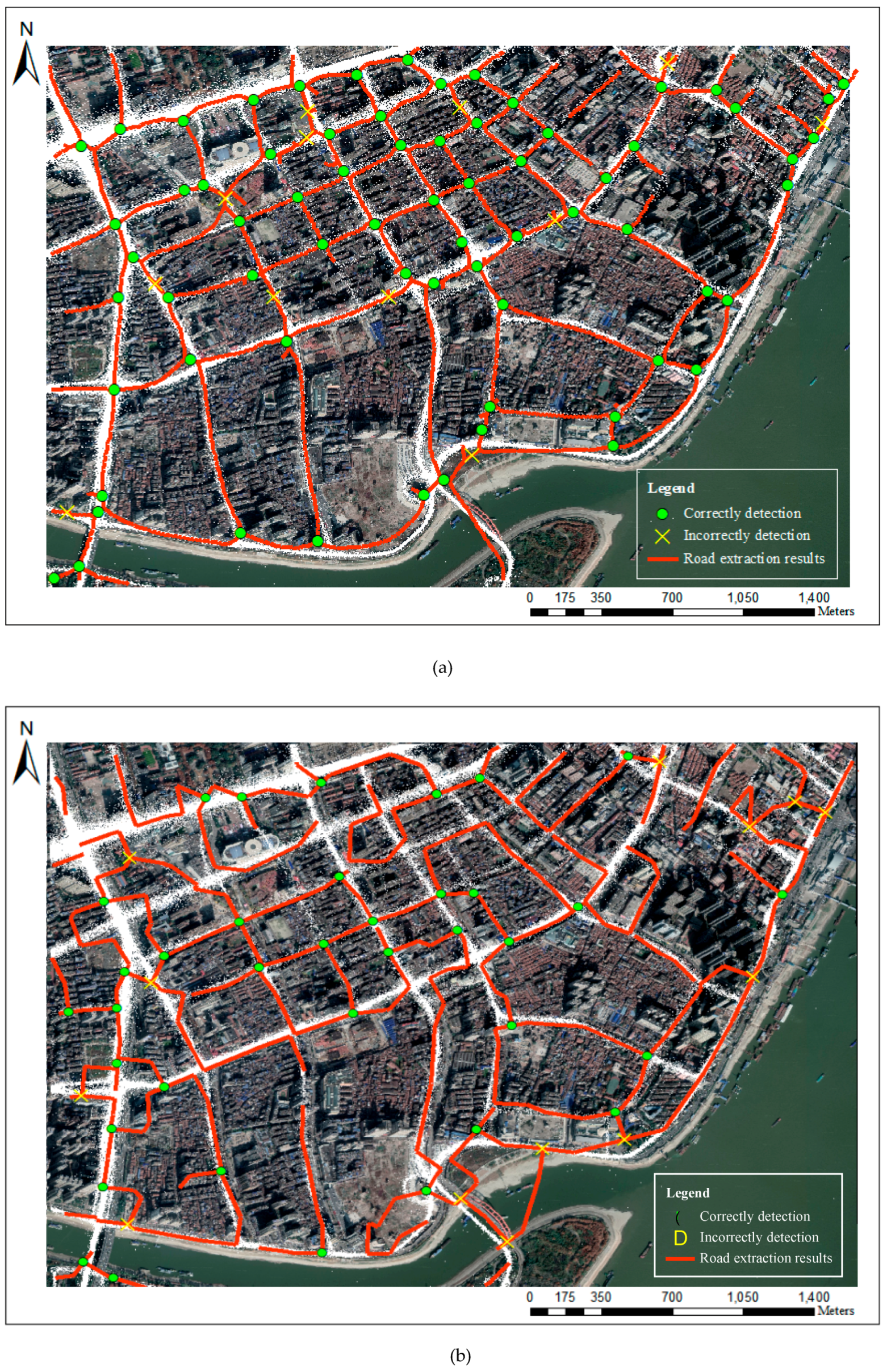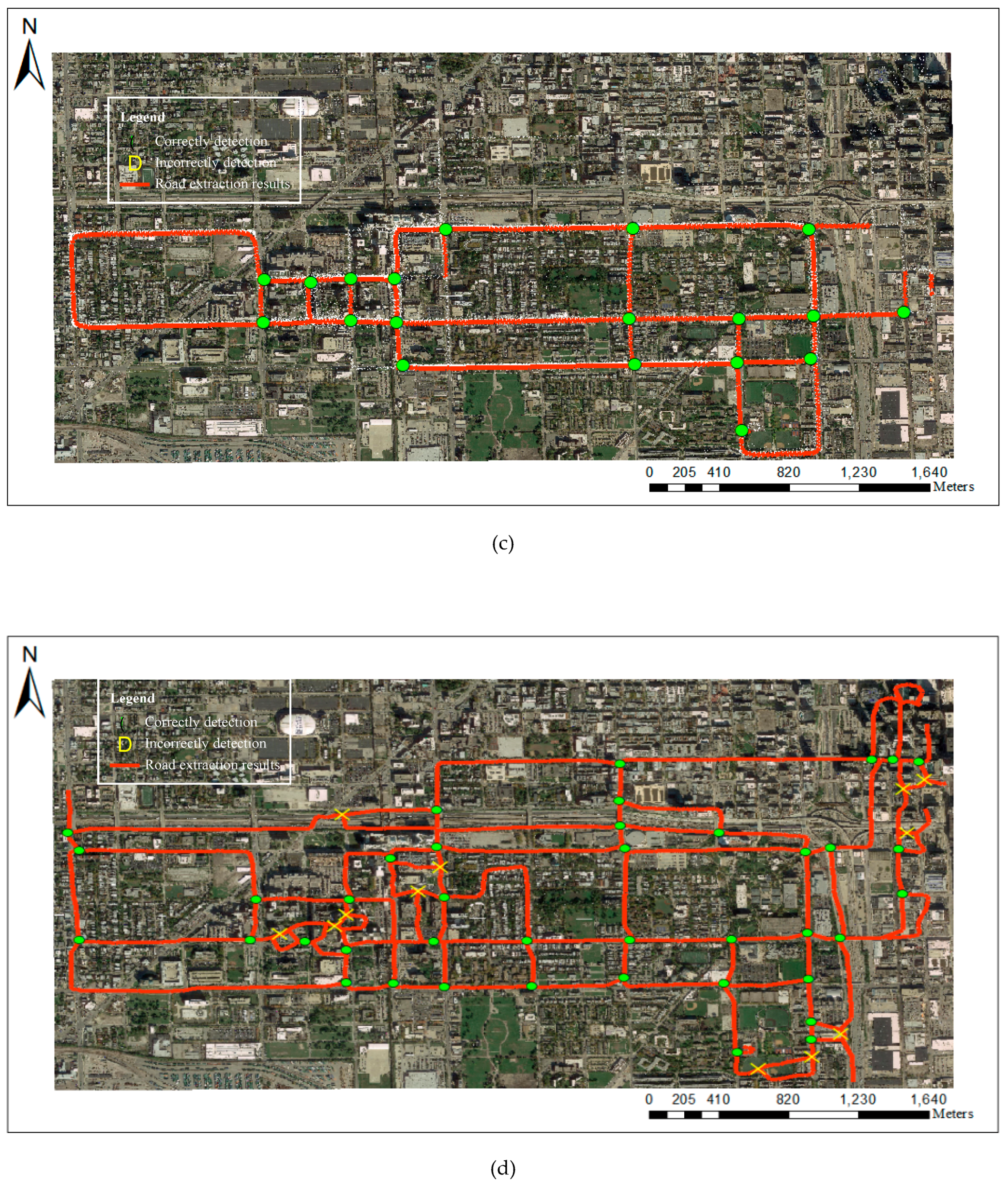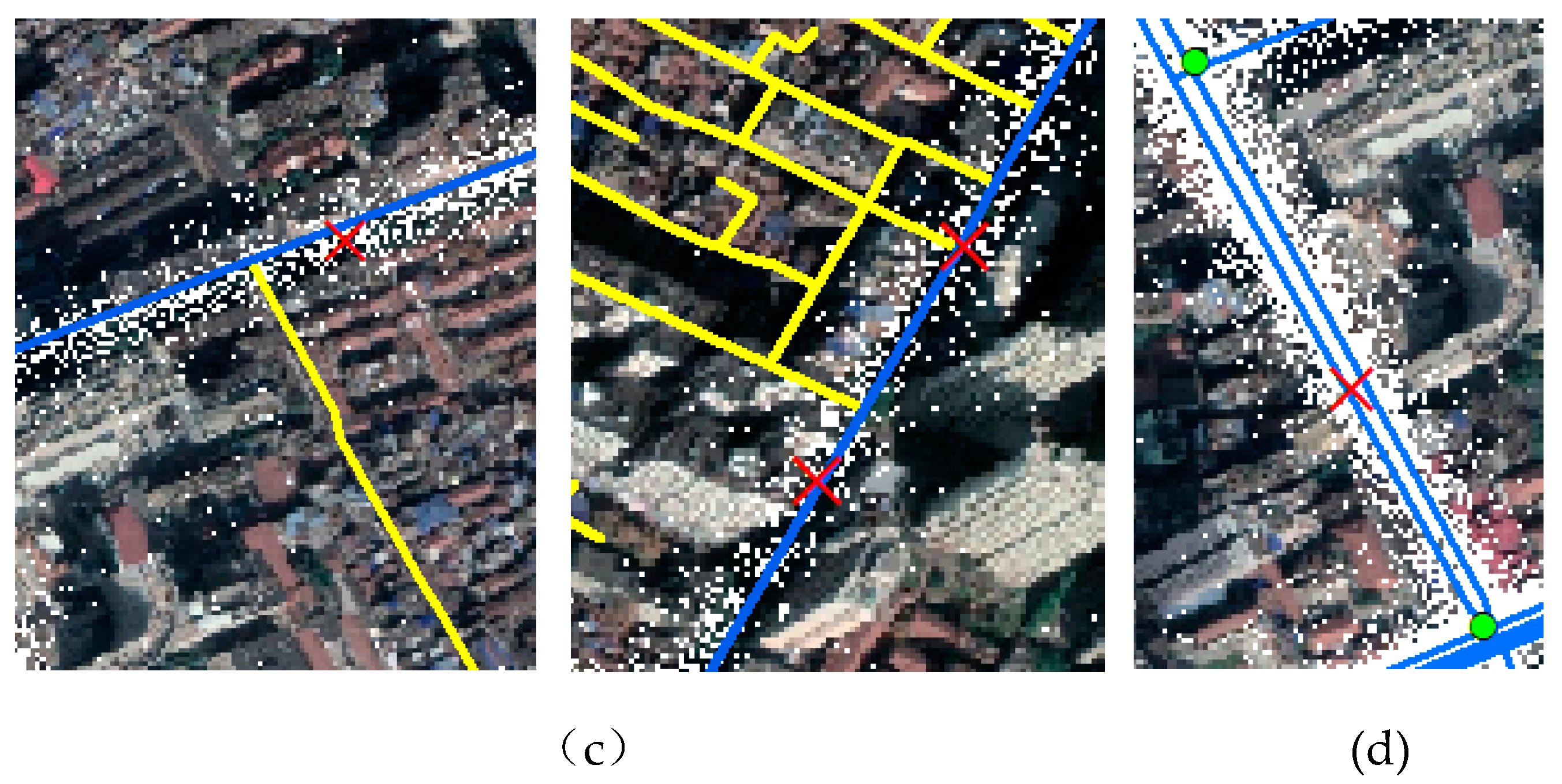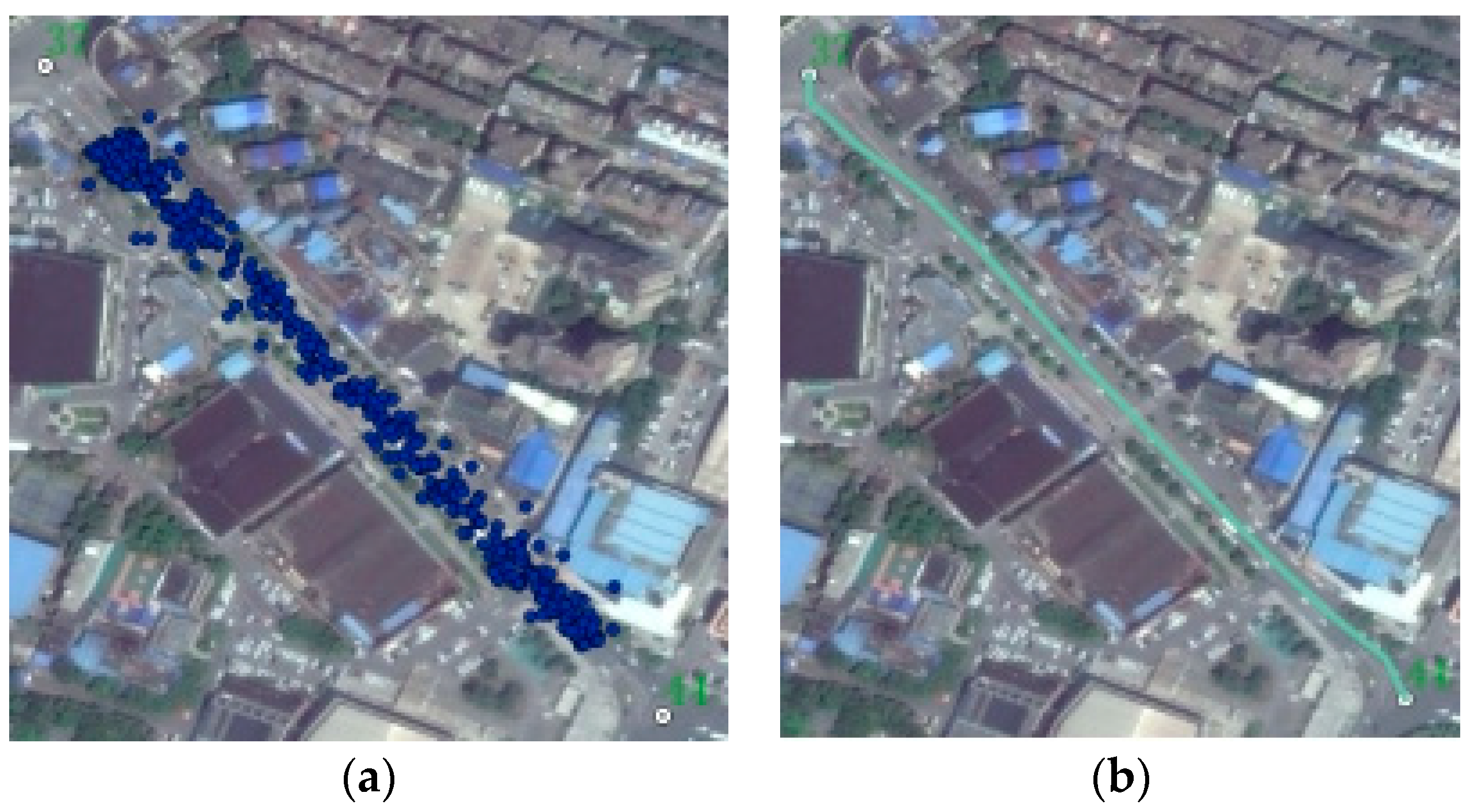1. Introduction
Digital road information is a pivotal part of basic geographic information and plays an important role in urban planning, intelligent transportation, and location services [
1]. In the past, the collection of road information, mostly through traditional measurement methods, had a high cost of time and manpower. With the development of remote sensing technology, many scholars have proposed road extraction methods based on remote sensing images [
2,
3] and Light Detection and Ranging (LIDAR) point cloud data [
4]. However, due to the mixture of multiple spatial information, road extraction is susceptible to interference. Additionally, the acquisition cost of remote sensing images and point cloud data is high and has a lag problem. Although it is possible to collect and edit data via a Mobile Mapping System, this method is also expensive, and road extraction information also often lags behind the latest changes in the actual road. With the development of the Internet and the popularity of GPS technology, the methods of geographic information acquisition have undergone tremendous changes. More and more locations can be reached via GPS or hand-held devices. Additionally, data are collected and uploaded by the public. These phenomena stimulate the generation of crowd-sourced trajectory data, which are acquired by soliciting contributions from a large group of volunteers. These data are different from those obtained by traditional measurement and remote sensing methods and have the advantages of being low cost, in real-time, and on a large scale, which is more suitable for the acquisition and rapid update of large-scale rural [
5] and urban [
6] road networks. At the same time, these data contain a large amount of driving record information, which makes a great contribution to the extraction of road-related geometry and attribute information, such as sidewalk networks [
7], implicit entities [
8], road boundary information [
9], road slope and aspect information [
10], and other road semantic information [
11,
12,
13]. Therefore, the big real-time traffic data from crowd-sourced data not only make it a reality to extract a low-cost, fast-updating, highly detailed, and accurate road network, but can also mine a lot of road semantic information. This is a significant research field for road information extraction.
At present, existing studies dedicated to generating road maps from vehicle GPS traces are common and have made great progress. Previous work mainly focused on the extraction of the road skeletons, which can be divided into incremental methods [
14,
15,
16], clustering methods [
17,
18,
19], and raster methods [
20,
21]. Incremental methods combine routes one-by-one to form a graph [
22], which starts from an empty road network, taking the first trajectory as the benchmark, and continuously adjusts and improves the initial road network by gradually inserting the trajectory. Clustering methods use some kind of clustering algorithm, such as K-means, to form a road network by considering the position or direction characteristics of the tracking points. Raster methods first rasterize the GPS track points to form a binary map and then use image-processing techniques to extract the road network.
However, incremental methods are calculation-intensive and cannot determine the correct intersections. Clustering methods, on the other hand, have difficulty handling roads that are close in space. These two kinds of methods can only process high frequency, high precision, and high-density trajectories; they perform poorly for low frequency and high GPS error data. Even though the raster method can fit low-frequency trajectories, the precise geometry and correct topology of road networks cannot be guaranteed, and the morphology of a road is often distorted. As shown in
Figure 1, the intersection position often deviates its right location and road segments around intersections with a few track points often distorted and broken.
To overcome the shortcomings of previous road data extraction methods based on the trajectory data, some studies argue that correct intersections can generate a high-quality road network, and some researchers have begun to do studies on the extraction of road intersections based on Longest Common Subsequence (LCSS) [
23], heading direction changing [
24,
25,
26,
27], G index analysis [
28,
29], shape descriptors [
30], etc. Additionally, some researchers [
27,
28,
29] have attempted to extract turn rules based on clustering methods. However, the above road intersection extraction methods are either complex or inefficient [
30], need to train a large number of data and build an empirical model to be viable, or are only applicable to high-frequency sampling data or high-density areas.
Therefore, there exist many challenges for road network extraction from crowd-sourced vehicle GPS trajectories, as follows:
First, high-frequency tracks are hard to obtain. Low-frequency tracks are more common, and most trajectory data are obtained by Commodity GPS devices in which the average sampling interval is more than 40 s, which means that the next points are often recorded after the vehicle passes one or more intersections. Thus, most methods mentioned above are inefficient for this kind of data.
Second, trajectory data are unevenly distributed, and road track points are intensive in traffic hub regions, while sparse in branch roads.
Third, the urban road network is extremely complex, as its intersections have multiple levels and types and may be too close to each other, meaning that the extraction of precise road segments around intersections cannot be guaranteed. Moreover, the morphology of a road is often distorted and broken for its low-frequency data properties.
In order to overcome the aforementioned challenges, a new intersection priority strategy to extract the road network using real-world vehicle GPS trajectory data was presented in this paper. We developed an integrated identification strategy focusing on the detection of road intersections and then constructed road improvement methods based on intersection results. The contributions of this paper are the following:
- (1)
In grid space, we extracted the intersections by identifying the number of eight neighborhoods, per pixel, in the single-pixel “center-lines” and considered different resolutions, which can keep as many intersections as possible in our extraction method and also make the extraction results more accurate in the subsequent fusion processing.
- (2)
In vector space, the clustering method to rapidly search for and find density peaks (CFDP) [
31] was used to extract road intersections for the first time. Moreover, our method, which considers the distribution density of trajectory data and the traffic flow characteristic of roads, is available for both low-frequency and high-frequency trajectories, thereby solving the problem faced by other methods, such as heading and speed only being available for high-frequency trajectories.
- (3)
An intersection fusion mechanism that integrates the advantages of cluster computing and image recognition was developed to overcome sampling sparseness and uneven distribution of the vehicle trajectory data. At the same time, this fusion mechanism can recognize true intersections and undetermined intersections, thereby guaranteeing the integrity of the extraction results and reducing the blindness of eliminating false intersections.
- (4)
Making full use of the direct dependency between intersections and center-lines of the road can further adjust road information and repair fractured segments, thereby guaranteeing the precision of road segments around intersections. We also constructed an Intersection–Link model and used the road segment between intersections as the unit to identify single/double directional information and the turning relationships of the road network, to guarantee the precise geometry and correct topology of the road networks.
The remainder of this paper is organized as follows.
Section 2 describes the method’s flow and the strategy used to extract the intersections and build a road network.
Section 3 outlines the procedure of our integrated intersection extraction method.
Section 4 outlines the procedure of our method for building a road network.
Section 5 presents a set of experimental analyses.
Section 6 discusses the conclusions and suggestions for further work.
3. Integrated Intersection Extraction
Road intersections, which usually connect two or more road segments, are key parts of the road network. In this study, we extracted the road intersections first and then processed the road information. To ensure the accuracy and integrity of the result’s location, two methods were used to extract intersections. One method involves using mathematical morphology to calculate the trajectory raster images of different resolutions, and the other involves clustering the GPS trajectories to obtain the "road cluster point" via the clustering algorithm CFDP. The intersection results are obtained by fusing these two methods, so the intersection extraction is as complete as possible while the position maintains high accuracy.
3.1. Extracting Intersections under a Raster Space Using the Morphology Method
Mathematical morphology processing, which has been widely used in the road extraction of remote sensing images, is a computational method for grid space. Remote sensing images contain a variety of different spectral information, which have a great impact on road extraction, while images generated by rasterization based on taxi GPS trajectories are not interfered with by other ground information, thereby producing better results. In addition, using the mathematical morphology approach requires less time to process the trajectory data. Based on our observations, the cells in which the number of pixel points in eight neighborhoods is more than two in single-pixel “center-lines” have the greatest opportunity to be road intersections. As shown in
Figure 3, cell
a is an example of a road intersection, while cell
b is an example of a non-intersection. In this study, we used the mathematical morphology method to obtain the single-pixel “center-lines” and extracted the intersections by identifying the number of pixels in each pixel’s eight neighborhoods.
The key steps for extracting road intersections via the morphological method are as follows:
Step 1: Rasterizing the GPS trajectories. In order to minimize the effects of noise, we set a statistical value c for each pixel based on the characteristics of a large number of track points, and specify that when a track point falls into a pixel of the raster image, the value of c for that pixel will be increased by 1. If the c value of a pixel is ultimately greater than or equal to the given threshold, the pixel value is set to 255; otherwise, the value is 0.
Step 2: Preprocessing the raster image. To accurately restore the shape of the original image, the etched image is used as the marker image and the original image as the mask image for the mathematical morphological reconstruction to eliminate outliers. At the same time, the reconstruction involves an iterative dilation process, which can ensure that holes are filled without changing the shape of the object. Operation preprocessing, such as open and close operations, can also be used to achieve image enhancement and smoothing, respectively.
Step 3: Extracting the single-pixel “center-lines” of the road by morphology thinning (shown in
Figure 4).
Step 4: Calculating the number of pixels in each pixel’s eight neighborhoods in the thinning result. The pixels whose neighborhood numbers are more than two are considered as intersections.
After preprocessing of mathematical morphology, the intersections can be obtained more accurately. However, when the trajectory points are rasterized, the resolution of the trajectory raster image will affect the final extraction result. Using a higher resolution, the location of the road can be reflected more accurately, as shown in
Figure 5a. However, for areas where the track points are sparsely distributed, such processing may generate more outliers that will be treated as noise and eliminated. If using a lower resolution, as shown in
Figure 5b, the proportion of trajectory pixels in the total number of pixels will increase, which facilitates the enhancement of sparse areas. Therefore, according to the strategy mentioned above, this paper uses high resolution and low resolution to extract road intersections, respectively, so our method can extract as many intersections as possible and also keep the extraction results more accurate in the subsequent fusion processing.
Urban road widths are diverse, ranging from 30 to 40 meters wide for main roads and 10 to 15 m wide for secondary roads. In order to accurately reflect the location of all roads and reduce the impact of noise, the raster resolution should not be too small. Therefore, two resolutions of 2.5 m and 5 m were selected for morphological processing. The intersection and center-line extraction results from different resolutions via rasterization using the Wuhan dataset are shown in
Figure 6. The results show that the number of 2.5 m intersection extraction results is 66, the number of 5 m extraction results is 77, which is 11 more than the number of 2.5 m extraction results.
Even though the method considers sparse areas and sets different kinds of resolutions to extract intersections, it is still not suitable for less dense regions, as some center lines and intersections in sparse areas have still not been completely extracted. Therefore, it is necessary to combine the peak density clustering method and mathematical morphology method to extract the intersections to ensure the completeness of the results.
3.2. Extracting Intersections Under a Vector Space Based on CFDP
Due to the complexity of the intersections, a large number of GPS sampling points are gathered near the intersection so, although the GPS trajectories of some areas near intersections are sparse, the density clustering algorithm can be used to extract intersections. The CFDP clustering algorithm is used in this work because it captures the local maximum density positions of cells and is not easily disturbed by uneven track density distribution. Moreover, the CFDP algorithm has a few threshold settings. In contrast, DBSCAN merges proximal high-density cells into clusters; the mean shift algorithm is often affected by locally dense areas, and the results fluctuate greatly.
The GPS trajectory points in the study area range from thousands to millions, and the presence of discrete points (noise points) may result in the detection of false intersections. Since it is impossible to process the entire study area directly using the CFDP algorithm, KDE is used for data smoothing.
3.2.1. Estimating Density
KDE is used to calculate the density of the point elements, which represents the sum of the kernel functions that fall within the bump, as shown in Equation (1):
where m is the number of neighbor cells, x
i is the center point of the
ith cell, h is the bandwidth, and K(x) is the kernel function adopted in this work, as shown in Equation (2):
In the density grid, large-value cells always exist within intersections, and small-value cells (also called noisy cells) usually exist at the margins of intersections or along roadways, as shown in
Figure 7a. Based on the statistics of the density grid, we can acquire a statistical distribution map, as shown in
Figure 7b. Setting the appropriate threshold K, we can extract the main road information, which consists of high-density cells for intersection detection.
3.2.2. Extracting Intersections
The CFDP algorithm is based on the assumption that the cluster center is surrounded by neighboring points with lower local densities and has a relatively large distance from any point with a higher density. Thus, for each point in the whole research region, two quantities are calculated: the local density of the point and the distance from the point to the point with a higher local density, both of which depend on the distance between the data points.
Based on estimating density processing, experimental data retains the main information about the intersection, and some noise points are removed while the number of data is reduced. Moreover, the extracted results have the density attribute
. Then, let set
denote a descending order of set
. In other words, as
, then the point distance is defined as Equation (3):
According to the decision diagram of the relationship between and , the cluster center, which is a candidate for intersection points, can be selected. Because the distribution of the GPS sampling points is inconsistent, if the distance and density threshold are considered at the same time, the sparse area extraction results will be affected, and the integrity of the extraction results will be reduced. Therefore, this paper takes into account the special qualities of intersections and only considers the distance threshold.
With the processing of the kernel density analysis, the data cluster is smoothed, and the distance within the cluster is suppressed. The larger the distance between the clusters, the more likely the intersection is. Amplifying the range of the red rectangular in the decision graph shown in
Figure 8b, we can see that the distance of many points clusters under 20 meters. Thus, setting the distance threshold D as 20 meters, the extraction results using the Wuhan dataset via the CFDP algorithm are shown in
Figure 8c. The extraction of the intersection is only related to distance, which solves the difficult parameter adjustment problems.
3.3. Fusion and Eliminating Pseudo Intersections
In order to reduce the blindness of eliminating pseudo intersections and ensure the integrity and accuracy of the extracted intersections, this paper establishes a corresponding fusion mechanism based on the extraction results of different methods to distinguish between true intersections, pseudo intersections, and undetermined intersections. This study also uses PCA to eliminate pseudo intersections. The road intersections fusion frame is shown in
Figure 9.
3.3.1. Fusion of the Intersection Extraction Results
Considering the density characteristics of the road intersections compensates for the morphology extraction results, but also results in some pseudo intersections. Consequently, we proposed a variety of fusion rules (listed in
Table 1) based on our extraction results, including high-resolution results, low-resolution results, and CFDP clustering results, to help recognize the undetermined results and reduce the error rate of eliminating pseudo intersections. If only high-resolution results or low-resolution results are present within the distance of a given fusion threshold R1, then the intersections are false. If only the CFDP clustering results are present, then the intersections are undetermined. In other situations, the fusion results are based on the high-resolution results (if they exist). Otherwise, the fusion results are based on the low-resolution results.
Based on the above rules, we set 80 meters as the fusion threshold value. The fusion results distinguish 79 true intersections, 4 false intersections, and 57 undetermined intersections, which are shown in
Figure 10.
Undetermined results all come from clustering results that greatly supplement the raster extraction results, especially the intersections of the residential streets, living streets, and pedestrian streets that have no (or few) taxi tracks. However, the congestion in some sections of the road and long taxi stays result in a large number of loci, and some pseudo intersections have also been extracted. We also extracted a method to eliminate the pseudo intersections, focusing on the undetermined results.
3.3.2. Elimination of False Intersections from Undetermined Results
Pseudo intersections (that is, non-real intersections) that are identified as intersections may be caused by taxis stopping, cars turning at gas stations, viaducts, or other special road landmarks. For this reason, we use the PCA method to analyze the linear significance of spatial distribution near undetermined intersections, which are extracted based on the above fusion rules to further distinguish pseudo-intersections from undetermined intersections. First, we created a circular buffer with radius R2 at the undetermined intersection to collect the track points falling into the circular buffer. Then, we construct a covariance matrix by taking x and y coordinates from the set of track points as variables and calculate the eigenvalues λ1 and λ2 of the matrix. Finally, we use Equation (4) to judge the main direction of traffic flow at the undetermined intersections and the intensity in each direction. It is obvious that the larger the Δ, the stronger the linear feature, which means the less likely it is to become a true intersection, as shown in
Figure 11. In order to retain more true intersections, we can choose the larger Δ value as the threshold value to filter the intersection points. Δ is calculated based on the following formula:
4. Road Network Generation
According to the above work, we extracted the single-pixel “center-lines” of the road by morphology thinning. Our goal was to produce an initial road map consisting of nodes and edges. Thus, we first vectorized the skeleton image and used the Douglas–Peucker algorithm [
32] to produce the edges that make up the shape of each road segment. Secondly, in order to determine the road integrity and topological consistency, we used the extracted intersections to adjust the distorted road segments around the intersection and connected the fracture segments to guarantee the road network’s accuracy. Finally, we designed the Intersection–Link model and took the road segments between the intersections as the units to identify the single/double directions and turning relationships of the road network.
4.1. The Road Improvement
The road segments around the intersections are distorted and broken. In this section, we build buffers for intersections. We set 80 m (the same as the fusing threshold R1) as the buffer radius and designed the specific algorithm to adjust the roads’ endpoints falling into the buffer of the relative intersections to correct the position and shape of the road segments around the intersections, as shown in
Figure 12a,b. At the same time, we also connected the fractured segments according to the broken segment’s distance and direction deviation, or the distance and direction deviation between the broken segment and the relative intersection, by using extracted intersection results, as shown in
Figure 12c,d.
Except for the intersection extraction results of set I in this stage, this connecting strategy requires to detect the suspension points set S and the suspension lines set L and to calculate the following two parameters: dis(pm,pn) < 500 m or dis(pm,Pi) < 500 m and dir(lm, (pn-pm)) < 30o or dir(lm, (Pi-pm)) <30o, where,,. The point that satisfies the above conditions and has the minimum distance will be selected to connect the suspension point. These parameters were determined based on the distance and direction between fractured segments as well as after much experimental exploration to yield the best results.
4.2. Identifying Single/Double Directions and Turning Relationships
A road intersection is an intersection of two or more roads that divide the urban road network into sections of moderate length without overlapping. Therefore, we designed the Intersection–Link model and used the road segment between intersections as the unit to identify the single/double directions and turning relationships of the road network.
4.2.1. Intersection–Link Model Construction
Building the Intersection–Link model is a process of track segmentation. A track is divided into several sections according to the road intersections, and each pair of adjacent road intersections corresponds to multiple track segments. Denoting any two adjacent road intersections in the node set as Ik and Ij, traversing the original track data, and calculating all n track segments between them, the Intersection–Link model can be obtained:
Here, tk(0<k≤n) represents the information of a track segment between Ik and Ij, which are two adjacent road intersections, including track ID and the track point coordinate information.
The Intersection-Link model’s construction is used to assign the original track points to an adjacent road intersection. For any track, it is necessary to determine which point passes through a road intersection. If two points in the track pass through two road intersections successively, then the point between them belongs to the section between these two intersections.
4.2.2. Removing the Pseudo-Intersection–Link Relationship
Due to the low sampling frequency of the track data, some tracks may cross several sections before passing through a road Intersection, thereby forming a pseudo-Intersection–Link relationship. Then, we adopted the following strategies to eliminate the pseudo-Intersection–Link relationship:
We use the straight line connecting the two road intersections as the diameter to establish the circular buffer zone. If there are too many other intersections in the buffer, the two intersections are too far apart. If so, delete the Intersection–Link relationship of the two intersections.
The Intersection–Link relationships are formed between two of the three road intersections (such as a, b, and c), which are located in the same straight line. The lengths of ab, ac, and bc were calculated accordingly to eliminate the Intersection–Link relationship of the longest pair of intersections, as shown in
Figure 13a.
Most sections of urban roads are straight lines, while some sections have small radians. Based on this observation, the maximum distance d from the intersection line (let the length be L) in the normal track points is calculated. If d/L is greater than the threshold, then delete the Intersection–Link relationship. This strategy can eliminate the situation seen in
Figure 13b.
4.2.3. Determining the Characteristics of a Road Network
The Intersection–Link model shows the relationship between road segments and track segments, which can be used to identify the single/double directions and turning relationships of the road network. Suppose the start-and-end intersections of a road section are a and b, respectively. The Intersection–Link relationship only exists between a to b or b to a, indicating that this road section is a single-lane road section. The Intersection–Link relationship exists between a to b and b to a, indicating that the road section is a two-way road section. Take road intersection 3 in
Figure 14 as an example. Intersections 2 and 3 have an Intersection–Link relationship. Intersections 3 and 4 have an Intersection–Link relationship at the same time, which is insufficient to indicate that there is a turning relationship between the two sections. Thus, the track segment in two Intersection–Link relationships needs to be checked. If the track segment between intersections 2 and 3 belongs to the same track as the track segment between intersections 3 and 4, and the vehicle’s time from intersection 2 to 4 does not exceed a certain threshold, then it can be determined that there is a turning relationship between section A and section D at intersection 3. It is worth mentioning that the number of intersections that can be used for turning at road intersections is often more than those that cannot be used for turning, so the selection of storage turning restriction relationships can effectively improve the storage efficiency.
6. Conclusions
Crowd-sourced Vehicle Trajectories have the disadvantage of lower accuracy, lower sampling frequency, more noise, and uneven distribution, which makes it more difficult to determine a road network than in most existing approaches that use high precision and high-frequency GPS trajectories. Thus, because these problems cannot be solved by a single method, we focused instead on the identification of urban road network intersections, proposing an integrated strategy that considers both dense and sparse areas, in order to extract intersections using density peak clustering and mathematical morphological processing in vector space and raster space, respectively. Compared with the traditional detection algorithms for road intersections, our methods have higher detection accuracy and integrity, as well as good application value and practical significance for quickly building road networks and acquiring more fine digital information. At the same time, based on the extracted road intersection information, this paper improves the morphology road network extraction results and makes them more closely resemble the real road. The proposed Intersection–Link model can also detect the single/double direction information of road sections and extract the turning rules of intersections.
In summary, the proposed method represents a considerable advancement in generating a navigable digital road network. However, improvements are still required to make the method better, such as considering the random forest algorithm and other technologies to further improve the accuracy of eliminating pseudo intersections and optimizing the extraction algorithm and calculation process to achieve real-time application. Moreover, our method only focused on the location of urban road intersections and urban road skeleton information, without considering more road semantic information (such as road congestion information, road grades, driving time, road slope, and aspect information) and detailed road geometry information (such as the shape of complex interchanges, road lanes, sidewalk network). In the future, we will consider elevation data, Point of Interest (POI) data, and remote sensing data together with all kinds of crowd-sourced GPS traces to mine more significant road information, which will involve not only the urban road network but also the rural road network.

